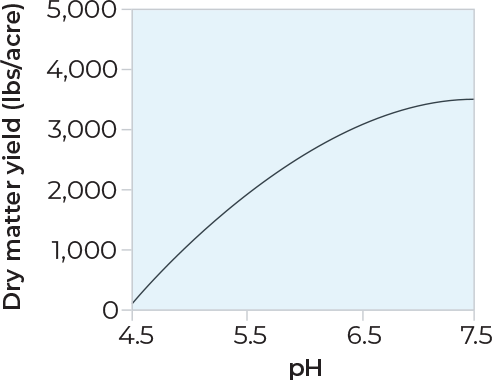The basics of alfalfa production and products
Fertility requirements
Optimal soil pH for alfalfa is 6.5 to 7.5. Alfalfa planted in a soil pH lower than 6.5 and higher than 7.5 will likely produce less than its potential and be more susceptible to diseases and pests (see Chart 1). Studies have shown alfalfa plants in a soil pH of 5.5 had a 10% survival rate to the second year, while survival rates in a field with a soil pH of 6.5 were close to 40%. Nutritional quality decreases as the soil becomes more acidic or alkaline. For example, tests have shown alfalfa from a 5.6 soil pH had up to 4% lower protein content than the same product in the same field with a pH of 6.5. For every ton of dry matter produced, an alfalfa stand consumes a significant amount of nutrients (see Table 1 on page 36). Micronutrient applications can greatly increase plant health and yield. Tissue sampling can be the best way to determine what micronutrients are needed.
Chart 1
First-cutting alfalfa yield relative to soil pH

Wollenhaupt and Undersender. University of Wisconsin, 1991
Predicting yields
For peak yield, a stand should have about 55 stems per square foot. For every 10 stems less than 55, the stand yields about 1 ton less dry matter per acre each year. Growers should consider rotating out when stem count falls below 40 per square foot. See Chart 3 for more information.
Doctor checkup
To measure the health of your stand, dig up roots and cut the crown and taproot in half. If the center of the crown and taproot is bright white/yellow, the plant is healthy and likely has at least two years of good production remaining. If some black crown rot is starting to show in the center of the crown/taproot, the field should be taken out of production after that growing season. If the crown/taproot of plants throughout the field has more than 60% black/brown discoloration, the field is not economical and should be converted to another profitable forage immediately.
Chart 2
Alfalfa stand age and yield (fall dormancy 4)

Dan Undersander, Forage Agronomist, University of Wisconsin Cooperative Extension, 2001
Number of harvests
Alfalfa experts have concluded that alfalfa, regardless of variety, has about 20 economical cuts in its lifespan. After 20 cuts, the plant is starting the downhill slide of its life. It may continue to grow for years, but its production significantly declines. If harvest yields are carefully measured, growers will often discover that after 20 cuts, yield has dropped to a point where it is economically advantageous to terminate the field and establish a new field. See Chart 2 for more information.
Chart 3
Alfalfa stem count and yield potential

Dan Undersander, Craig Grau, Dennis Cosgrove, Jerry Doll, and Neal Martin, University of Wisconsin Cooperative Extension, 2011
Nutrient needs
| Potassium (K) | 49 |
| Calcium (Ca) | 30 |
| Phosphorus (P) | 6 |
| Magnesium (Mg) | 6 |
| Sulfur (S) | 6 |
| Iron (Fe) | 0.33 |
| Manganese (Mn) | 0.12 |
| Boron (B) | 0.08 |
| Zinc (Zn) | 0.05 |
| Copper (Cu) | 0.01 |
| Molybdenum (Mo) | 0.002 |
Pounds of nutrient removed per ton of dry matter produced, according to the University of Wisconsin.

